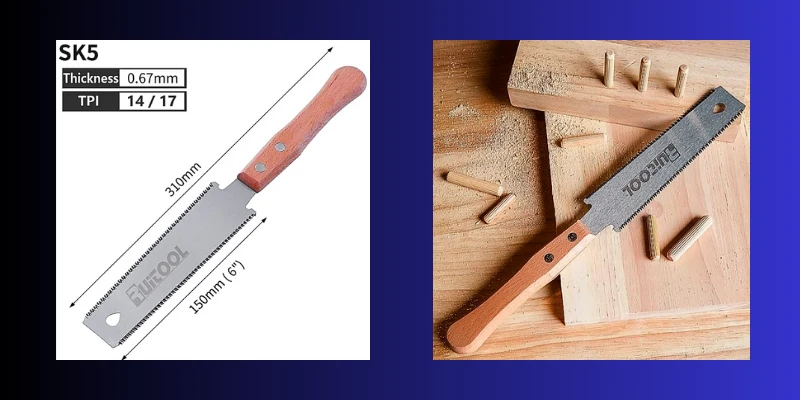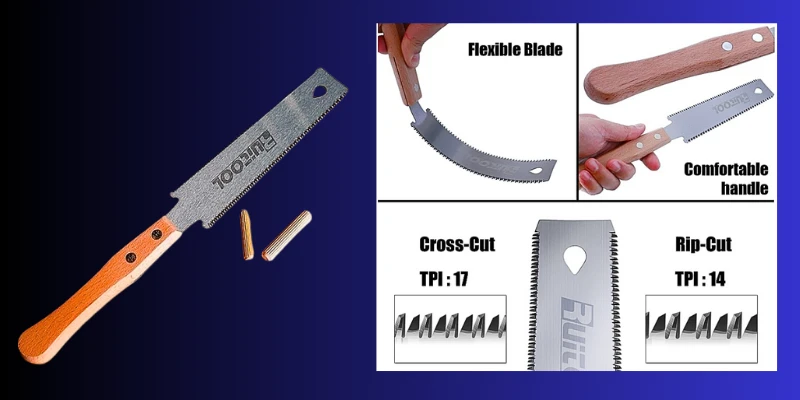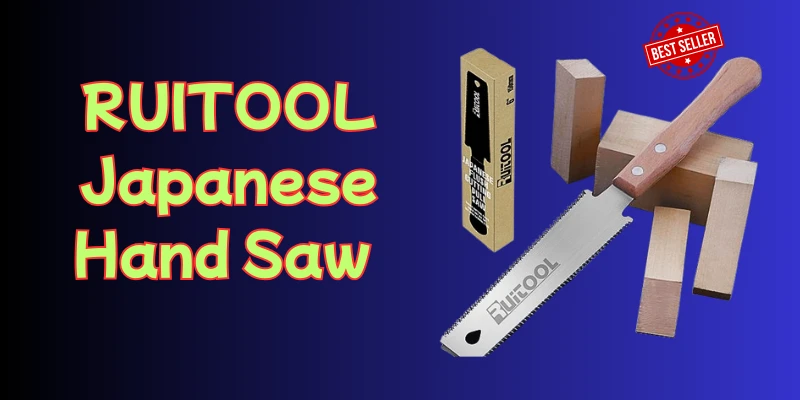Introduction to Japanese Hand Saws
Japanese hand saws, commonly known as “Noko” saws, have been integral to traditional woodworking practices for centuries. Unlike their Western counterparts, these saws operate on a pull stroke rather than a push stroke. This unique design enables greater control and precision during cutting, leading to superior results in both fine woodworking and general carpentry. The ability to cut on the pull stroke allows users to apply more accurate pressure, which reduces the likelihood of blade deflection and minimizes the risk of splintering the material being cut.

Within the realm of Japanese hand saws, the Ryoba saw is particularly notable. It features a dual-edged blade, offering one side for ripping along the grain and the other for crosscutting across it. This versatile tool is a testament to the meticulous craftsmanship that Japanese woodworking tools are renowned for. The thin and flexible blade of the Ryoba allows for intricate cuts and fine detailing, making it a favorite among artisans who appreciate the elegance of traditional techniques paired with modern efficiency.
The historical significance of Japanese hand saws cannot be overstated. Their design is rooted in the unique needs of Japanese woodworking practices, which emphasize precision and artistry. The evolution of these tools reflects not just advancements in technology but also cultural values that prioritize harmony in design and functionality. As woodworking techniques have evolved, the tradition of using Japanese pull saws has remained relevant, particularly among contemporary woodworkers who value the precision and control these tools offer.
In today’s market, the popularity of Japanese hand saws continues to rise, appealing to both professionals and hobbyists alike. Their ergonomic design, coupled with the quality of craftsmanship, ensures that woodworkers can achieve high levels of accuracy in their projects. Thus, understanding the characteristics and historical context of these tools is essential for anyone looking to enhance their woodworking skills.
Understanding the RUITOOL Ryoba Saw
The RUITOOL 6-inch Ryoba saw is a remarkable example of traditional Japanese craftsmanship, ingeniously designed to cater to various woodworking needs. One of the standout features of this tool is its double-edged blade, which enhances its versatility. On one side, the saw is optimized for rip cuts, allowing users to efficiently cut along the grain of the wood. Meanwhile, the opposing edge is crafted for cross-cuts, providing a means to cut against the grain. This dual functionality makes the RUITOOL Ryoba saw a valuable asset for woodworkers requiring a single tool to perform multiple tasks.
Precision is a hallmark of the RUITOOL design. The saw boasts a high-quality blade that combines strength with flexibility, allowing for smoother cuts and better control. The blade is designed with specific teeth per inch (TPI) ratings that vary according to the side of the saw. The rip-cut side typically features fewer teeth, ensuring faster cuts through thicker materials, while the cross-cut side has a higher TPI, allowing for a finer finish on thinner pieces. The careful selection of these TPI ratings ensures that woodworkers achieve the desired results without compromising on quality.
Moreover, the ergonomic design of the handle contributes significantly to user comfort and stability during operation. When utilizing the RUITOOL Ryoba saw, woodworkers can achieve cleaner cuts with less effort, minimizing fatigue during longer projects. The craftsmanship evident in the saw’s design, combined with its functional features, makes it an excellent choice for both amateur and professional woodworkers alike. Its adaptability in various cutting applications exemplifies why the RUITOOL 6-inch Ryoba saw is a must-have tool in any workshop.

SK5 Steel: The Heart of the Blade
One of the standout features of the RUITOOL Japanese hand saw is its blade, forged from high-quality SK5 steel. This steel is notably recognized for its unique combination of toughness, edge retention, and ease of sharpening, making it an excellent choice for a variety of woodworking tasks. When discussing toughness, SK5 steel demonstrates an impressive resistance to wear and deformation, which is critical for maintaining the blade’s integrity during extensive use. This durability translates to less frequent replacements and prolonged periods between sharpenings, both significant advantages for woodworkers who value efficiency and performance.
Another important characteristic of SK5 steel is its exceptional edge retention. Unlike softer steels, which may quickly lose their sharpness, blades made from SK5 maintain a finely honed edge longer, allowing for cleaner cuts and reduced effort when sawing through different types of timber. This quality is particularly beneficial for those engaged in precise woodworking or delicate tasks, as it helps ensure that each cut can be executed with utmost accuracy. Furthermore, the long-lasting sharpness of SK5 steel enhances the overall user experience by minimizing the time spent on maintenance and sharpening.
Ease of sharpening is yet another advantageous property of SK5 steel. With the right tools and techniques, woodworkers can quickly restore the blade to its original sharpness when required. This ease not only improves the longevity of the saw but also allows artisans to focus more on their craft rather than the upkeep of their tools. As a result, the inclusion of SK5 steel in the RUITOOL Japanese hand saw significantly enhances its performance, positioning it as an invaluable asset for both amateurs and seasoned professionals alike. The properties of SK5 steel work together to provide an optimal balance of strength, usability, and convenience, making it the heart of this exceptional woodworking tool.
The Significance of the Beech Handle
In woodworking, the choice of materials plays a pivotal role in the overall functionality and user experience of the tools. The RUITOOL Japanese hand saw, specifically the Ryoba variety, features a beech wood handle that exemplifies thoughtful craftsmanship and design. Beech wood, known for its tensile strength and resistance to wear, offers a perfect blend of durability and aesthetic appeal, making it an ideal choice for the handle of a precision cutting tool.
The ergonomic design of the beech handle enhances user comfort during extended use. A well-designed handle minimizes strain on the wrist and hand, allowing for greater control and precision while cutting. The natural properties of beech wood, including its smooth texture and firm grip, contribute to a tool that feels secure and comfortable in the user’s hands. Such ergonomic principles are essential in hand tool design, as they promote better handling, ultimately leading to improved accuracy and reduced fatigue.
Aesthetically, beech wood provides a warm, appealing finish that enhances the overall look of the Ryoba saw. Its light color and fine grain pattern add elegance, making it a visually pleasing addition to any woodworking toolkit. Moreover, beech wood is often praised for its ability to age gracefully, developing a patina that further enhances its character over time.
Incorporating a beech handle in the design of the RUITOOL Japanese hand saw not only fulfills functional requirements but also elevates the user experience through comfort and visual appeal. The significance of the beech handle extends beyond mere material choice; it is integral to the saw’s performance and the satisfaction of the craftsman wielding it. Such design considerations reflect a commitment to quality that is deeply valued in the realm of Japanese Ryoba tools.
Applications in Woodworking
The RUITOOL Japanese hand saw, specifically the Ryoba type, has gained significant popularity among woodworking enthusiasts and professionals alike due to its unmatched precision and versatility. This tool is engineered to handle a variety of woodworking applications, making it an invaluable asset in any workshop. One prominent application is in joinery, where the Ryoba saw excels in cutting precise dovetail and miter joints. The dual-edged blade, offering pull and push capabilities, allows woodworkers to create smooth, clean cuts that are essential in maintaining tight-fitting joints.
In addition to joinery, the RUITOOL Japanese hand saw is excellent for cabinetry work. The ability to cut both softwoods and hardwoods with accuracy means that this tool is perfect for crafting high-quality cabinets and furniture pieces. Its lightweight design and razor-sharp blade allow for intricate cuts that are necessary for achieving fine details, ensuring that the final product meets the highest standards of craftsmanship. This saw is particularly beneficial for making bevels and complex angles, which are common in customized cabinetry projects.
Fine finishing work is another area where the Ryoba saw shines. Woodworkers often require precise cuts to ensure a polished look, and the RUITOOL Japanese hand saw‘s design allows for a level of control and finesse that is difficult to achieve with other tools. Whether trimming edges or making delicate cross-cuts, this hand saw enables users to enhance the overall appearance of their projects. Choosing the right tool, such as the RUITOOL Japanese hand saw, is critical for specific tasks. By using a tool designed for the nuances of woodworking, craftsmen not only improve efficiency but also elevate the quality of their final output.
Comparison with Other Hand Saws
The RUITOOL Japanese Ryoba saw stands out in the realm of hand saws, particularly when juxtaposed with both traditional Japanese and Western hand saws. At the heart of its design, the Japanese hand saw features a double-edged blade, allowing users to perform both crosscuts and rip cuts without needing to switch tools. This unique feature elevates its versatility significantly compared to Western saws, which typically possess a single cutting edge designed for a specific task.
When assessing cutting performance, the Ryoba’s thin blade and razor-sharp teeth provide a clean and precise cut, often outperforming many Western hand saws. The Japanese method of constructing these blades ensures that they cut on the pull stroke, allowing for greater control and less effort. In comparison, Western saws usually cut on the push, which can result in a more rigorous cutting experience. This fundamental difference not only influences precision but also affects user fatigue, making the Ryoba an excellent choice for extended woodworking sessions.
Ease of use is another critical aspect where the Ryoba excels. Its lightweight design and ergonomic handle promote reduced strain on the user, permitting faster work without compromising accuracy. In contrast, some Western hand saws can be bulkier, which might lead to cumbersome handling, particularly for fine detail work. For beginners, the Ryoba saw can be more forgiving since it allows for a greater margin of error through its unique cutting technique.
In terms of versatility, the Ryoba saw is well-suited for a variety of woodworking tasks. Whether tackling dovetails, tenons, or intricate joinery, this tool adapts seamlessly, where many standard Western saws have more limited applications. Thus, the combination of precision, ease of use, and versatility positions the RUITOOL Ryoba saw as a superior option for woodworkers seeking high-quality performance across diverse applications.
Maintenance and Care Tips
Proper maintenance and care of the RUITOOL Japanese hand saw, particularly the Ryoba model, are essential for ensuring its longevity and effectiveness. By adopting a few best practices for cleaning, sharpening, and storing the saw, users can enhance its performance and extend its lifespan.
Firstly, after each use, it is critical to clean the saw blade to remove any debris and resin. This can be accomplished using a soft cloth or a gentle brush. For more persistent residues, a mixture of water and mild detergent is recommended. Be sure to dry the blade thoroughly after cleaning to prevent rust formation, which can significantly affect the performance of the saw.
Regular sharpening is another vital aspect of maintaining your Ryoba saw. Unlike Western saws, which are often thicker and more robust, Japanese Ryoba saws feature a finer blade that requires careful handling. Using a diamond file or a specialized saw file, gently sharpen the teeth of the saw, focusing on maintaining their original angles to ensure clean cuts. Performing this task periodically will not only improve cutting efficiency but also reduce wear on the blade.
Another critical maintenance tip is the proper storage of the saw. It is advisable to store the RUITOOL Japanese hand saw in a dry place, preferably in a protective sheath or case. This helps prevent accidental damage and minimizes exposure to moisture. Additionally, applying a light coat of machine oil to the blade before storage can further protect it from rust and degradation over time.
By adhering to these maintenance and care tips, users can effectively prolong the life and effectiveness of their RUITOOL Japanese hand saw, ensuring it remains a reliable tool for various woodworking applications.
User Experiences and Testimonials
The RUITOOL Japanese hand saw, particularly its Ryoba model, has garnered a diverse range of user experiences that illuminate its performance and practicality in various woodworking projects. Many users commend the razor-sharp dual-edged blade, which allows for efficient cross-cutting and rip-cutting in a single tool, simplifying their woodworking tasks. Among these users, hobbyists and professional carpenters alike have shared their satisfaction, noting that the saw’s lightweight design provides excellent maneuverability, making tight cuts easier to execute.
One user, a furniture maker, praised the precision offered by the Japanese hand saw, stating that the tool enabled him to achieve intricate joinery with minimal effort. The uniformity of the cuts, he elaborated, allowed him to enhance his craftsmanship significantly, creating elegant pieces that stand out due to their precise connections. Several other testimonials echo this sentiment, highlighting the saw’s ability to deliver a quality finish without requiring excessive sanding or additional work post-cutting.
However, despite the overwhelmingly positive feedback, some users have reported minor challenges. A few individuals mentioned that transitioning from traditional handsaws to the RUITOOL Japanese hand saw required an adjustment period. Initially, they found the technique of using the saw to be different, especially when applying the right amount of pressure and angle during cutting. Nevertheless, they acknowledged that with practice, the saw soon became an indispensable part of their toolkit.
Additionally, specific feedback has emerged regarding the maintenance of the saw. Users have emphasized the importance of keeping the blade clean and well-oiled to ensure optimal performance and longevity. Overall, the combined user experiences paint a comprehensive picture of the RUITOOL Ryoba saw as a practical tool that delivers both precision and ease of use in woodworking settings.

Conclusion: Is the RUITOOL Ryoba Saw Right for You?
In assessing the RUITOOL Japanese hand saw, specifically the Ryoba model, several key attributes lend themselves to be advantageous for both novice and seasoned woodworkers. The design reflects traditional Japanese craftsmanship, featuring a double-edged blade that allows for both rip and crosscuts. Such versatility can enhance project efficiency, making this tool an attractive addition to your woodworking arsenal.
The ergonomic handle provides a comfortable grip, significantly reducing fatigue during extended use, which is essential when tackling larger projects. Furthermore, the lightweight build of the RUITOOL Ryoba saw contributes to ease of maneuverability, allowing for precise cuts without cumbersome strain. These features combined create a user-friendly experience, particularly for those learning the intricacies of woodworking techniques.
However, potential buyers should also consider the specific needs of their projects. While the Ryoba saw excels in intricate joinery and detailed finishes, those who frequently work with larger timber or require rapid cutting may find other tools better suited for such tasks. Additionally, familiarity with traditional hand saw techniques may be necessary to fully leverage the RUITOOL’s capabilities, as modern electric saws often dominate today’s preferences.
Ultimately, whether the RUITOOL Japanese hand saw is right for you depends on your woodworking style and project requirements. For individuals seeking a precise, high-quality hand tool that honors the rich heritage of Japanese saw-making, the RUITOOL may be an excellent investment. Its myriad benefits, such as cutting precision and comfort, seamlessly align with the principles of high-quality craftsmanship. As with any tool, thoughtful consideration should be taken to ensure it complements your unique woodworking journey.



